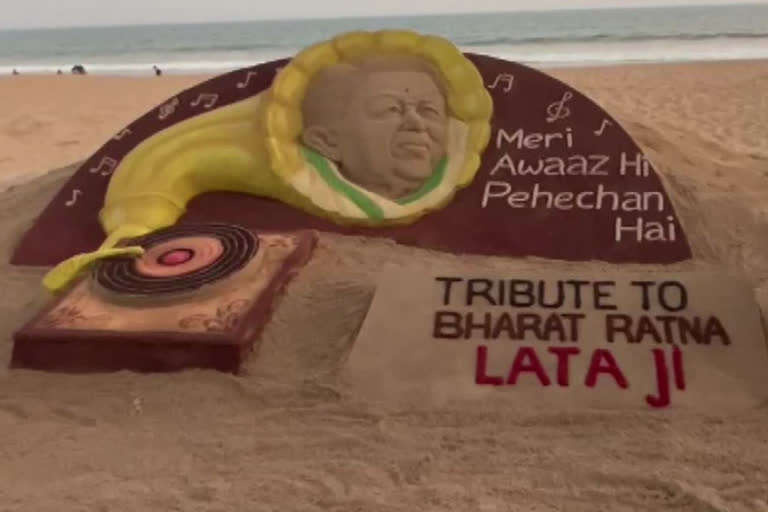Puri (Odisha) : Renowned sand artist Sudarsan Pattnaik has paid tribute to the evergreen musical empress of Bollywood Lata Mangeshkar on her first death anniversary through his art.
Sand artist Pattnaik created a 6ft high sand sculpture with the message 'Tribute to Bharat Ratna Lata Ji, Meri Awaaaz Hi Pehechan Hai', at Puri beach in Odisha. Lata Mangeshkar passed away on February 6 last year at Mumbai's Breach Candy Hospital at 92. Lata also known as Lata di, was a name that was synonymous with music in India. The Queen of Melody, who moved the entire nation with her deep influencing voice, was as melodious as a nightingale.
With a career span of almost eight decades, she was the recipient of awards like Bharat Ratna and Dada Saheb Phalke for her contribution to the Indian music industry. She represented an entire era, a movement and a lasting phase in the Indian music space. Her voice was so powerful that it transcended all barriers of language, caste, creed, culture, region and religion.
Lata, the eldest of five siblings was born on September 28, 1929, to a Marathi-speaking family in Indore, which was earlier a part of Central India Agency, but now in Madhya Pradesh. Her father Pandit Deenanath Mangeshkar was a classical singer and a noted theatre artist. Her mother Shevanti was a Gujarati woman from Thalner, Bombay Presidency, now in northwest Maharashtra. She was Deenanath's second wife, after his first wife Narmada, who was Shevanti's elder sister, died.
The first fruits of classical music were tasted by Lata at the tender age of five, under the auspicious training of her own father. He was a disciple of the Gwalior Gharana, which is a community of performers who share a distinctive musical style. She was also tutored by musical maestros like Aman Ali Khan Sahib and Amanat Ali Khan. The mantle of responsibilities fell on Lata's shoulders at the age of 13 with the demise of her father, due to heart disease. It was at that age that she recorded her first song, 'Naachu Yaa Gade, Khelu Saari Mani Haus Bhaari', composed by Sadashivrao Nevrekar for Vasant Joglekar's Marathi film 'Kiti Hasaal', though the song did not make the final edit. Navyug was a close friend of the Mangeshkar family.
During her teenage years, she struggled to support her family and in establishing herself as a playback singer in the Bollywood of the 1940s, a time when the profession was dominated by divas such as Shamshad Begum and Noor Jehan. Her first Hindi song was 'Mata Ek Sapoot Ki Duniya Badal De Tu' for the Marathi film 'Gajaabhaau' in the year 1943. Lata's first major break was with the song 'Dil Mera Toda, Mujhe Kahin Ka Na Chhora', penned by Nazim Panipat for the movie 'Majboor' in 1948. The song became her first big breakthrough film hit and after that, she recorded 'Uthaye ja unke sitam' for 'Andaz' in 1949, which sealed her destiny forever.
From that point on she did playback singing for every major leading lady, representing each generation of Bollywood from Nargis and Waheeda Rehman to Madhuri Dixit and Preity Zinta, till even. Music composers such as Naushad Ali, Madan Mohan, and S.D. Burman used to make tunes specifically to exploit the potential of her wide-ranging soprano. Her accuracy of whether holding a note or negotiating difficult passages that demand the agility of an acrobatic voice remained unmatched and exemplary throughout her career. Even the most celebrated singers are sometimes prone to slipping up, or hitting a slightly inaccurate note, but not Lata.
She was awarded the Padma Vibhushan in 1999, one of India's highest civilian honours. Just two years after that in the year 2001, she became the second film celebrity, after Satyajit Ray to receive the Bharat Ratna, India's highest civilian award conferred by the government for the highest order of performance in any field.
In the same year, she established the Master Deenanath Mangeshkar Hospital in Pune, which was managed by the Lata Mangeshkar Medical Foundation, founded in October 1989. Her 1987 song 'Wada Na Tod' from the film 'Dil Tujhko Diya' was included in the 2004 Hollywood film 'Eternal Sunshine of the Spotless Mind'. (ANI)
